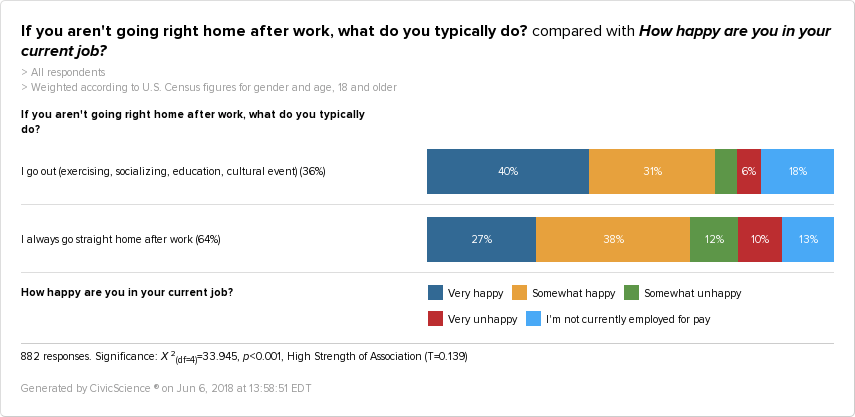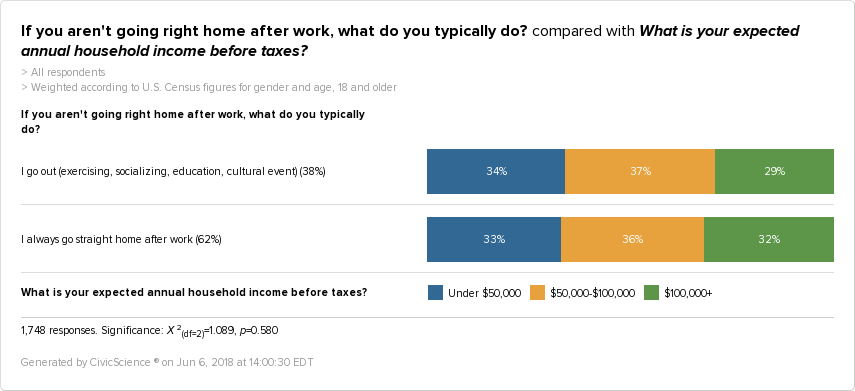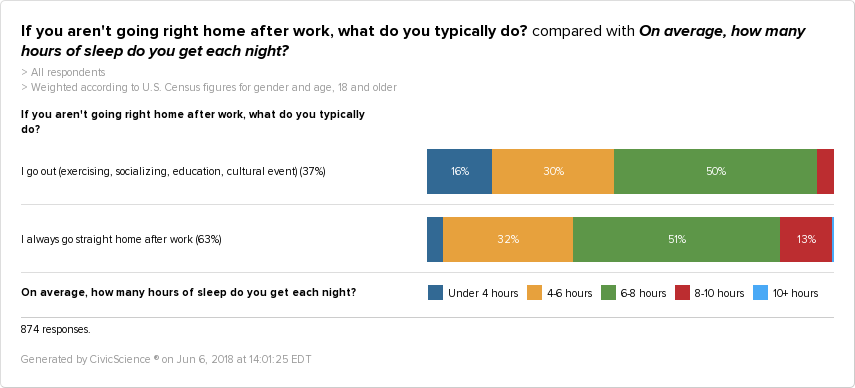The Gist: Over half of US adults always go straight home after work. Most prefer to be home either to handle family responsibilities or get some sleep. Those who do go out tend to spend more time on social media, suggesting conflicting motivations behind participating in the modern happy hour.
One of the mainstays of work culture has long been the happy hour–the transition between work and home that has historically been reserved as a social time, for colleagues to meet over libations and decompress after the day’s events. However, in recent years, the culture has shifted, welcoming in an array of other after-work activities, other versions of the happy hour, if you will, to help spice up the daily routine. Given the fact that there are so many options once the clock hits 5 pm (or 6 or 7), we wondered how US adults these days are spending their time?
As our data shows, 62% of US adults go straight home after work.
However, if we simplify our graph to show the total percentage of individuals who do something after work instead of going home, we see that 38%, or just over ⅓ of US adults do, in fact, go out.
So, what could be impacting our respondents in each category? Considering the fact that parental status likely plays a significant role in evening activities, let’s start there.
For those who go straight home after work, it’s fairly split between parents and nonparents. As for those who go out, non-parents make up 60%, while parents make up 40%. Although parents are the likely expected minority here, 40% is a strong figure. This could indicate that parents today are taking time for themselves as individuals, and not solely focusing on family life.
As it turns out, the largest percentage of parents who do go out have children between 12 and 17 years old.
From birth to the time their children turn 18, the percentage of parents who go out hovers between 8% and 11%. This behavior could parallel the growth and independence taking place in the child-parent relationship, as older children tend to require less supervision.
Another factor that could be impacting the choice to go out or go home is job satisfaction.
Those who are very happy with their jobs are far more likely to go out after work than those who are only somewhat happy. This indicates that the notion of the happy hour–in whatever form it may take–depends heavily upon individuals already being happy with their current jobs.
One item that seems to be a non-issue in the realm of after-work plans is income. The data shows us that income earners of all levels are split along almost exactly even lines.
So if spending time somewhere else between work and home is not a financial concern, and more than half of US adults are going straight home after work, could it be that home is the new happy hour? Family responsibilities aside, there are, it seems, plenty of benefits to coming home right after work.
For example, those who go home after work are less likely to skimp on sleep.
As we can see, 16% of those who go out after work get less than four hours of sleep on average each night. Those who go home, on the other hand, largely respect their bedtime.
Ultimately, those who go straight home may see it as a more absolute way to disconnect and wind down.
Although more of our homebodies do spend a casual amount of time on social media each day than their counterparts who are on the town, those who go out have higher percentages of extended daily social media use, with 17% spending four or more hours on social media each day. This leads us to wonder what could be motivating some to spend their evenings out? In 2018, is going out actually about enjoying an activity, or getting the Instagram photo to prove it happened?
At this point, it seems the happy hour looks a little different than it has in the past. While over a third of US adults are still going out after work, and many in that group are using the time to socialize with friends and coworkers in a more familiar happy-hour style, the vast majority of Americans are coming straight home, potentially to spend time with family or get a good night’s sleep.
As for those who do go out, we can only speculate as to whether the modern happy hour is fueled by the desire for a genuine experience or a stronger presence on social media.
















